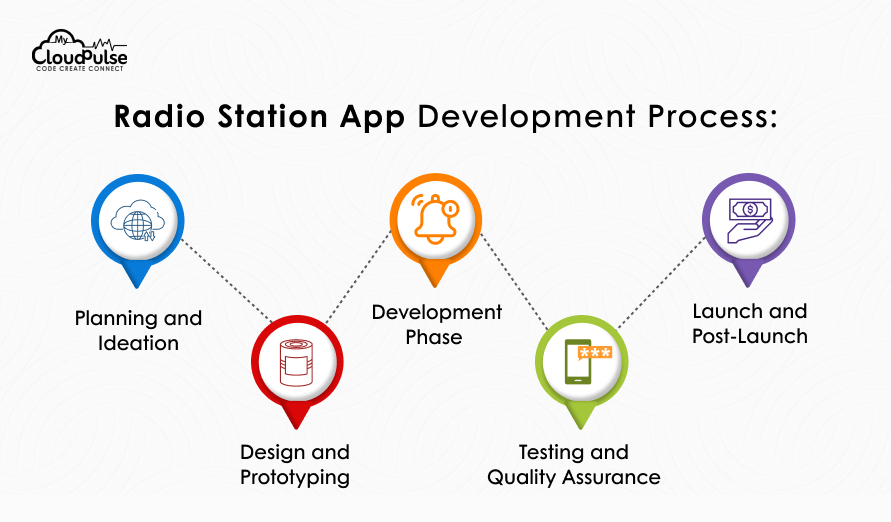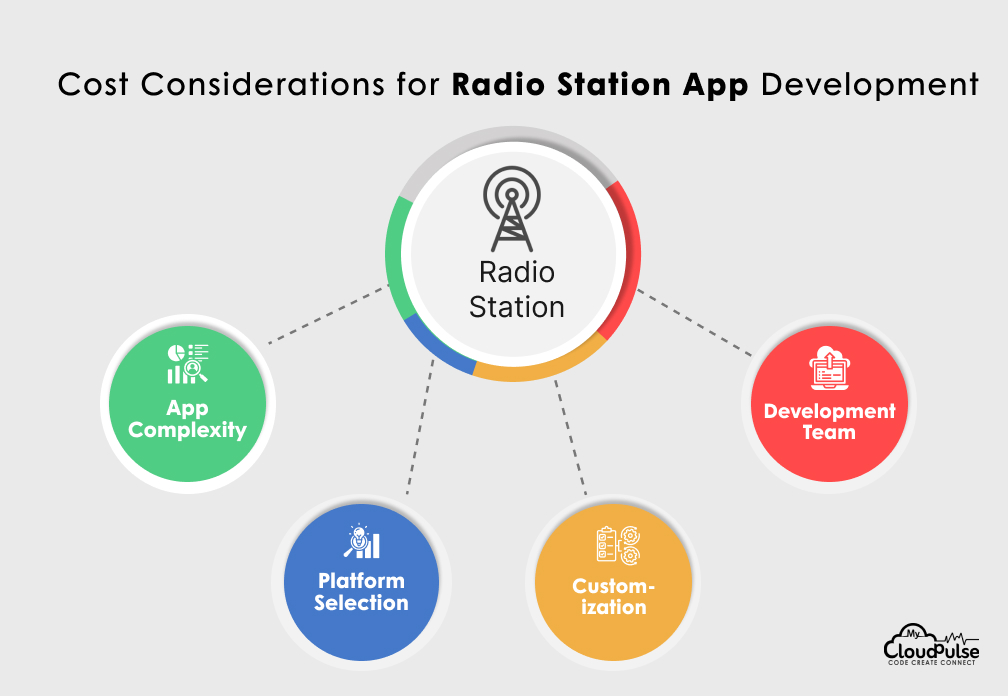The terrain of radio use is changing dramatically. Although conventional FM radio is still very much in use, the growing ubiquity of smartphones marks a new age of audio entertainment — that of radio station apps. These mobile apps let users tune in to their preferred stations anywhere, at any time, by providing unmatched simplicity and accessibility. For radio stations, this paradigm change offers a perfect chance to grow their audience involvement, stay competitive in a world becoming more and more digitalised, and increase their reach.
Covering all important elements like the development process, vital features, cost concerns, and the function of a seasoned development partner like CloudPulse, this thorough guide will explore the nuances of radio station app development.
Understanding Radio Station App Development
Fundamentally, radio station app development is creating a mobile application that lets consumers easily access and enjoy the live audio stream, on-demand content (podcasts, archived programs), and other interactive elements of the station. This is about building a customised and interesting audio entertainment centre for the contemporary listener, not just about reproducing the FM radio experience.
Creating a successful radio station app calls for a multifarious strategy combining technical knowledge, artistic design, and thorough awareness of user behaviour. To guarantee an easy and pleasant listening experience, user experience (UX) and user interface (UI) design must first take front stage.
How do Radio Station Apps Work: A Methodical Guide
Let us dissect the usual user path seen inside a radio station app:

1. Download and install:
Users start by downloading the application from the app stores — either Google Play Store or iOS App Store. Once successfully installed, the app offers many ways for consumers to find stations.
2. Station Discovery
Users may find various radio stations available in their area, by:
- Browsing: A well selected list of well-known stations arranged by genre (news, music, talk show etc.).
- Search: Excellent means to find certain stations by name or phrase.
- Location-Based Recommendations: Advice for nearby stations depending on the user’s current position.
3. Tuning In and Listening
Once a desired station is chosen, the app starts a live audio feed. First of importance is high-quality streaming, guaranteeing little buffering and flawless listening experience.
4. Exploration and Personalization
Many radio station applications include a spectrum of interactive elements, such as:
- Program Schedules: Show and host displays of forthcoming events.
- Podcasts, archival episodes, and special programming are on demand.
- Showing the artist, song title, and album artwork of now performing tunes.
- Let consumers store their preferred stations for easy access.
- Social Media Integration: Let users post to friends and followers on social media sites their listening experiences.
5. Background Listening
Crucially, background listening lets listeners keep listening to the station while using other apps on their smartphone or maybe with the screen closed.
Essential Features of a Radio Station App
The features of a radio station app determines its performance mostly. These are some of the most important aspects to give a thought:
- High Quality Streaming: Any effective radio station app is built on uninterrupted, high-quality audio streaming.
- Social Media Integration: Encouragement of flawless sharing of listening experiences throughout well-known social media sites would greatly increase reach and involvement.
- Background Playback: Maintaining user involvement and offering a flawless listening experience by letting people listen in the background.
- Program Schedule: Offering a thorough and easily navigable program schedule improves the listening experience and lets consumers arrange their listening sessions.
- On-demand Content: Offering podcasts, archived programs, and unique content gives listeners access to material outside of the current broadcast, therefore enhancing engagement and value.
- User Profiles and Customisation: Giving consumers the ability to build profiles, store favourites, and personalise their listening experience helps them to take responsibility and raises their level of pleasure.
- Sleep Timer: Perfect for listening before bed, a handy function of the Sleep Timer automatically turns down the app after a designated period.
- Interactive Elements: Interactive components such as competitions, quizzes, and polls help to increase listener participation and strengthen the community around the station.
Radio Station App Development Process: A Step-by-Step Guide
Creating a good radio station app calls both a methodical and iterative process:

1. Planning and Idea Development:
- Clearly define goals: Clearly state the app’s objectives (e.g., expand audience reach, improve listener involvement, create income).
- Research the listening habits, tastes, and expectations of the target audience thoroughly.
- Existing radio station applications should be examined in order to spot places for distinction, best practices, and original ideas.
- Find the fundamental elements that will most benefit consumers and complement the general goals of the app.
- Choose the target platform(s) for the app—Android, iOS, or both.
2. Prototyping and Design:
- User Interface (UI) Design: Design an aesthetically pleasing and user-friendly interface that is simple to use.
- Design of User Experience (UX): Emphasise on designing a flawless and fun user experience that gives accessibility and simplicity of usage top priority.
- Create interactive prototypes to evaluate app usability and user flow prior to moving on with full-scale production.
3. The Development Phase:
- Front-end Development: Create the app’s user interface and aspects of experience front end development.
- Back-end Development: Create the infrastructure and server-side logic to handle live streaming, on-demand content distribution, and user authentication — that is, the functioning of the app.
- Third-party Integration: Combine outside services like analytics systems, payment gateways, and social media APIs.

4. Testing and Quality Assurance:
- Test several devices and operating systems rigorously in order to find and resolve problems and guarantee best performance.
- Involve a group of target consumers to test the app and receive comments in order of user acceptance testing (UAT).
- Apply a strong QA procedure to guarantee the app is error-free and satisfies the highest quality criteria.
5. Launch and Post-Launch:
- App Store Submission: Submit the application to the relevant app stores — Apple App Store and Google Play Store for evaluation and clearance.
- Start an all-encompassing marketing effort to advertise the app and draw users in order.
- Provide continuous support and maintenance including bug fixing, performance enhancements, and frequent updates introducing new features and thereby enhancing the user experience.
Popular Radio Station Apps: An Interpretive Study
Several well-known radio station applications have been very successful on the market, such as:
- TuneIn Radio: A complete platform providing access to podcasts, audiobooks, news channels, and a large collection of radio stations from all over the globe. It provides a premium membership for ad-free listening and access to special content as well as a free edition with commercials.
- iHeartRadio: This popular platform has live radio stations, bespoke music stations, podcasts, and on-demand audio entertainment. It provides a paid membership for ad-free listening, on-demand playback, and unlimited skips as well as a free edition with advertising.
- SiriusXM: Offering a varied range of music channels, sports radio, discussion programs, and exclusive programming, as well as subscription-based services.
- Pandora Radio: A highly personalised music streaming company, Pandora generates unique radio programs depending on customer tastes.
- Spotify: Although mostly regarded as a music streaming service, it also provides a large range of podcasts and radio stations.
Factors Affecting the Cost of Radio Station App Development
Developing a radio station app might have somewhat different expenses based on numerous criteria:

- App complexity: Directly affecting development expenses are the quantity and degree of features.
- Platforms: Usually, building for iOS and Android costs more than developing for one platform.
- Customization: Costs will be influenced by the degree of customising needed — that is, by design features and distinctive branding.
- Development Team: The experience and knowledge of the development team is rather important in deciding expenses.
While more sophisticated applications with advanced features and significant customising might cost upwards of $25,000 or more, a basic radio station app with limited capabilities can cost anywhere from $10,000 to $15,000.
Ongoing Maintenance and Support
Apart from the first development expenses, continuous maintenance and support are needed to guarantee the success of the app. These expenses might comprise:
- Regular Updates: Including fresh features, performance enhancements, and bug fixes will help the app remain competitive and current.
- Server & Infrastructure: Maintaining the servers and infrastructure needed to enable the functioning of the app calls for careful expenses.
- Customer Support: Giving quick and competent customer assistance will help to answer questions and solve problems.
Why Choose CloudPulse for Radio Station App Development?
A leading mobile app development firm, CloudPulse has a history of developing excellent, creative, and user-centric apps. Having years of expertise and a staff of talented designers, developers, and project managers, we can assist you to convert your idea into a successful radio station app.
Our Experience Creating Radio Station Apps:
- Competitive App Development: From first idea and planning to design, programming, testing, launch, and continuous maintenance, we provide end-to- end app development services.
- Custom Solutions: We make sure the finished result exactly matches your brand and target audience by customising every project to your particular needs and specifications.
- Cutting-edge Technologies: Using industry best practices and the most recent technologies, we build scalable, user-friendly, high-performance radio station applications.
- UI/UX: User experience (UX) and user interface (UI) design are our top priorities in order to produce easy and interesting applications that enjoy using.
- Transparency: Open and honest communication is something we uphold all through the development process, therefore keeping you updated every stage.

Why Hire CloudPulse?
- Verified Track Record: We have a good history of providing customers in many sectors with effective mobile applications.
- Expertise: Our staff consists of very talented and experienced experts in all facets of mobile app development.
- Client-centric Approach: Using a client-centric approach, we give your requirements and goals first priority so that the end result lives beyond your expectations.
- Affordable Solutions: We provide reasonably priced and competitive solutions without sacrificing on quality or service.
- Strict Quality Control: Strict quality control policies help us to guarantee that the end result is dependable, bug-free, and runs best.
Get in Touch Now
To find more about our radio station app development services or to discuss your project needs, kindly get in touch with us right now. It would be great to work with you and support your goal attainment.
FAQs
Factors such as app complexity, functionality, platform choice, customising, and development team expertise will greatly affect the cost of creating a radio station app. While more complicated applications with sophisticated features can cost upwards of $25,000 or more, a basic app with limited capabilities might cost between $10,000 and $15,000.
The degree of the complexity of the app and the size of the project will affect the development timeline. Usually, development and launch of a radio station app takes two to six months.
Consider elements like experience, portfolio, client endorsements, communication style, cost, and quality commitment when choosing a development partner.
Emphasise on developing a high-quality user experience, properly advertising the app, getting user feedback, and constantly upgrading and refining the app depending on user demands and market trends to guarantee the success of your radio station app.
Among the many advantages radio station apps provide include more reach, more audience involvement, better listener loyalty, additional income sources via in-app sales and advertising, and the capacity to provide users individualised content and experiences.
I hope this thorough tutorial offers insightful analysis of radio station app creation. Please let us know if you need more particular information or have any additional queries.


